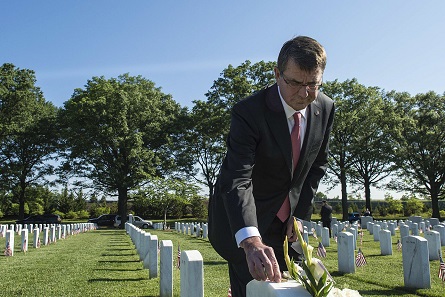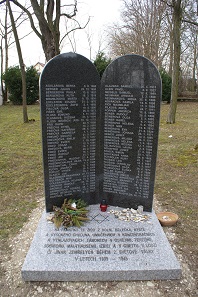by Leonie Schulze
translated by Christina Schlögl
August 9, 2018 – There are 147 American military cemeteries in the United States and 24 additional ones outside the national borders in France, Belgium, Tunisia and the Philippines, among others. They have one thing in common: you will often find coins on the headstones of fallen soldiers, which are placed there by family members, friends, and people they did not even know. The coin’s value leaves a message for the next visitor.
Decorated graves at Fort Logan National Cemetery in Denver/Colorado. Photo: Tony Massey / CC BY-SA 2.5.
Coins in combination with tomb stones are not all too surprising. After all, excavations on ancient Greek and Roman territories have repeatedly shown us that thousands of years ago people used to put coins in the mouths of people who had died. To this day, some cultures still put coins on their relatives’ eyes that are meant to keep their eyes shut. But why do Americans put coins on the headstones of fallen military members?
This modern tradition probably emerged during the Vietnam War in the 1960s and 1970s. The gesture is an expression of respect, and the value of the individual coin has a special meaning. A penny is supposed to let the soldier’s relatives know that someone visited the grave. Coins with a higher value indicate that a person was close to the deceased. A nickel means that they were in the same boot camp. Dimes are mostly laid down by soldiers from the same division. Sometimes one will even find a quarter. This means that the person was present when the soldier died.
In May 2015, former Secretary of Defense Ashton Carter put a challenge coin on the headstone of a family friend. Photo: Department of Defense, Sean Hurt.
Along with coins with a nominal value, one will also find medals (so-called challenge coins) on tomb stones. They are given to soldiers to indicate their affiliation with a certain unit. Some people also lay down these kinds of medals at their comrades’ graves. CoinsWeekly published a detailed article on the tradition of these challenge coins, which goes back to the time of World War I.
Many visitors have left little stones on this tomb stone in Holice (Czech Republic).
Some might now be reminded of the Jewish tradition of putting stones on burial places. In former times these devout gifts further augmented the size of the grave which was initially marked with a pile of stones. Despite the transition to marble tops and head stones, this tradition has survived.
Americans often visit military cemeteries on Memorial Day. The local news channel NewsChannel5 from Nashville (Tennessee) explained the tradition on this year’s Memorial Day in this short segment. In May of 2017, ABC Chicago talked to an American war veteran about why he puts a quarter on a head stone every year.
You can find more information on Jewish funerary culture at Planet Wissen. (Only in German)
One of the most popular CoinsWeekly articles answers the question of what is depicted on America’s small denominations.







